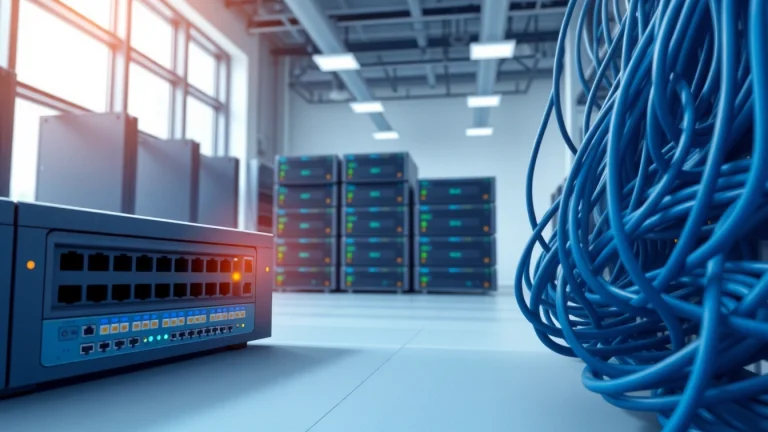
Understanding Network Infrastructure: Components and Significance for Efficient Operations
What is Network Infrastructure?
Definition and Overview
In the rapidly evolving landscape of technology, organizations increasingly depend on their network infrastructure for seamless communication and operations. Network infrastructure encompasses the various hardware and software components that facilitate connectivity, communication, and data transfer. This foundation not only supports internal processes but also connects organizations with the external digital world. Understanding the intricacies of network infrastructure is crucial for managers, IT professionals, and stakeholders to make informed decisions that enhance operational efficiency and drive innovation.
The Importance of Network Infrastructure
Network infrastructure is not merely a technological foundation; it is the backbone of modern communication. As businesses continue to digitize their operations, effective network infrastructure plays a vital role in achieving several key objectives:
- Enabling Connectivity: It provides the essential tools for devices, systems, and users to connect and communicate.
- Supporting Business Operations: From daily transactional communications to collaborative projects, network infrastructure ensures smooth operations.
- Enhancing Efficiency: Well-designed network infrastructure minimizes bottlenecks and maximizes the speed of information flow.
- Facilitating Innovation: With robust network infrastructure, organizations are able to explore new technologies, such as cloud computing and Internet of Things (IoT), enhancing growth and adaptability.
Key Terminologies in Network Infrastructure
Familiarity with certain terminologies is essential when discussing network infrastructure:
- Network Topology: The arrangement of different elements in a network, which can be physical or logical.
- Bandwidth: The maximum rate of data transfer across a network at any time, often interpreted as the network’s capacity.
- Latency: The time it takes for data to travel from one point to another in the network.
- Protocols: Sets of rules that determine how data is transmitted across the network.
- IP Addressing: A numerical label assigned to devices connected to a computer network that uses the Internet Protocol for communication.
Core Components of Network Infrastructure
Hardware Setup: Routers, Switches, and Cables
The cornerstone of any network infrastructure revolves around its hardware components. Here, we delve into the fundamental hardware necessary for establishing a reliable network:
- Routers: Devices that forward data packets between computer networks, guiding the information through complex paths.
- Switches: Network devices that connect devices within a network and manage data flow efficiently by sending packets only to the intended devices.
- Cabling: The physical connections (like optical fiber, which provides high bandwidth, or copper cables) that interlink various devices in a network.
Each of these components plays a pivotal role in determining the efficiency and reliability of network connectivity.
Software Essentials for Managing Network Infrastructure
Alongside hardware, software solutions are crucial for managing and optimizing network infrastructure. Key software components include:
- Network Management Systems (NMS): Tools that monitor network performance, allowing administrators to act promptly on issues and enhancing network reliability.
- Firewall Software: Security applications that protect networks from unauthorized access and threats, essential for maintaining data integrity.
- Virtual Private Network (VPN): Software that creates secure connections over the internet, ensuring privacy and security for data transmitted over public networks.
By leveraging these software solutions, organizations can better manage their network infrastructure, ensuring its operational effectiveness and security.
Physical vs. Virtual Network Infrastructure
When discussing network infrastructure, it is essential to differentiate between physical and virtual setups:
- Physical Network Infrastructure: Involves the tangible components such as servers, routers, cables, and data centers. The physical setup requires maintenance and management of hardware.
- Virtual Network Infrastructure: Involves software-based systems that emulate traditional networking hardware and components. This is increasingly popular due to the flexibility and scalability it offers, especially in cloud computing.
Understanding both forms allows organizations to adapt their infrastructure according to specific needs, enabling them to achieve desired levels of performance and agility.
Designing Efficient Network Infrastructure
Best Practices for Network Infrastructure Design
Creating a robust network infrastructure requires strategic planning and adherence to best practices. Here are essential strategies to consider:
- Assess Current Needs: Identify the specific requirements of your organization – number of devices, applications in use, and data transfer needs.
- Invest in Scalability: Design the network with future growth in mind, allowing for additional devices and increased traffic without major overhauls.
- Redundancy Planning: Implement backup systems for key components to maintain network operations in case of failure, minimizing downtime.
- Prioritize Security: Integrate security measures into the design from the onset, ensuring all components are fortified against potential threats.
Common Pitfalls in Network Infrastructure Setup
When establishing network infrastructure, certain common mistakes can undermine effectiveness. Awareness of these pitfalls can guide better planning:
- Ignoring Scalability: Failing to consider future needs may result in costly upgrades down the line.
- Overlooking Security: Not implementing robust security measures can expose the network to breaches, leading to significant data loss or theft.
- Neglecting Performance Monitoring: Without ongoing assessment, it’s challenging to identify performance issues before they escalate into bigger problems.
- Poor Documentation: Inadequate documentation of network architecture can lead to confusion and inefficiency when troubleshooting or planning expansions.
Planning for Future Scalability
It’s essential to create a network infrastructure that can grow alongside your organization. Some strategies for ensuring future scalability include:
- Utilize Modular Components: Opt for hardware that can be easily expanded or upgraded as requirements change.
- Choose Cloud Solutions: Leverage cloud computing for flexible resource management, allowing for easy adjustments to capacity based on demand.
- Monitor Traffic Patterns: Regularly assess the data flow to forecast future needs and adjust the infrastructure proactively.
By implementing these practices, organizations can construct a resilient network infrastructure poised for long-term success.
Network Infrastructure Security
Defining Network Infrastructure Security Challenges
The increasing complexity of networks raises various security challenges that organizations must address to safeguard their data:
- Unauthorized Access: External threats or internal breaches can compromise data integrity and confidentiality.
- Malicious Software Attacks: Malware and viruses can disrupt operations, leading to costly downtimes and potential data loss.
- Network Vulnerabilities: Weak points in the network can be exploited by cybercriminals, making ongoing assessment vital.
Implementing Best Security Practices
To mitigate these risks, organizations must adopt best security practices such as:
- Regular Updates and Patching: Ensure all software and hardware components are kept up to date, incorporating critical patches to defend against emerging threats.
- Access Control: Implement strict user permissions to ensure only authorized personnel have access to sensitive data.
- Network Segmentation: Dividing the network into separate segments can limit the spread of security threats and enhance monitoring.
Monitoring and Managing Security Risks
Continuous monitoring and management of network security are necessary to effectively respond to ever-evolving threats:
- Employ Intrusion Detection Systems (IDS): These systems can identify and alert on potential breaches in real-time, allowing for immediate action.
- Conduct Regular Security Audits: Regular assessments of the infrastructure and security policies ensure vulnerabilities are identified and addressed promptly.
- Educate Employees: Regular training on security awareness can empower employees to recognize and respond to potential threats.
Evaluating Network Infrastructure Performance
Key Metrics for Assessing Network Infrastructure
To ensure network infrastructure operates effectively, organizations must evaluate performance through specific metrics:
- Bandwidth Usage: Measure the amount of data transmitted over the network to ensure capacity is sufficient for business needs.
- Latency: Track the time delay for data transfers, ensuring it remains within acceptable limits for performance.
- Error Rates: Monitor the incidence of data packet losses or failures to determine network reliability.
- Overall Network Availability: Assess the operational uptime to ensure minimal downtime, impacting business operations.
Tools for Performance Monitoring
Numerous tools are available to assist with monitoring network performance effectively, including:
- Network Performance Monitoring Tools: These applications provide insights into overall network health and performance analysis.
- Network Traffic Analysis Tools: Solutions that track data flows and identify potential bottlenecks.
- Endpoint Monitoring Solutions: Monitoring tools focused on individual devices can track performance and identify potential issues.
Optimizing Network Infrastructure for Efficiency
Enhancing network infrastructure efficiency involves both configuration and operational strategies:
- Traffic Shaping: Implementing techniques to prioritize essential services, ensuring critical data is transmitted smoothly even during peak usage times.
- Load Balancing: Distributing workloads evenly across servers helps prevent any single server from becoming overloaded, improving performance.
- Regular Maintenance: Routine checks and maintenance of hardware and software keep the network functioning optimally.
By prioritizing these strategies, organizations can ensure their network infrastructure operates not only effectively but also efficiently, aiding in their overall success.


